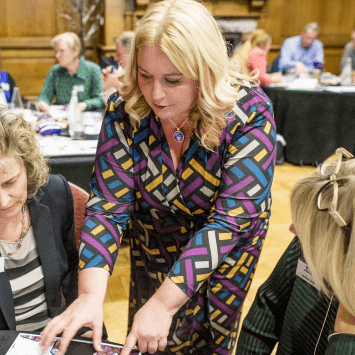Posted in Blog, Facilitation, Meetings by Jo North
Mastering the Art of Leadership Team Meetings: Tips and Best Practices
In the fast-paced, changing world of business, effective leadership team meetings are essential for success. They provide an opportunity for leaders to align their goals, collaborate on strategy, and make informed decisions. However, mastering the art of these meetings is no easy feat. From managing diverse personalities to keeping the discussion focussed, there are numerous challenges to overcome.
In this article, I’ll delve into the tips and best practices that can help you become a master of leadership team meetings. I’ll explore strategies for setting clear objectives, facilitating productive discussions, and fostering a culture of collaboration. Additionally, I’ll discuss meeting materials and decision-making processes.
Whether you’re a seasoned executive or a rising leader, this article will provide you with valuable insights to enhance your leadership team meetings. By incorporating these tips and best practices, you can transform your meetings into powerful platforms for driving innovation, fostering teamwork, and achieving organizational goals. So, let’s dive in and unlock the secrets to mastering the art of leadership team meetings.

The Importance of Effective Leadership Team Meetings
Effective leadership team meetings serve as a crucial platform for aligning goals and driving organizational success. These meetings provide leaders with the opportunity to share information, make decisions, and foster a culture of collaboration. By bringing together diverse perspectives and expertise, leadership team meetings enable strategic thinking, business innovation and creative problem-solving.
30 Tips and Best Practices for Highly Effective Leadership Team Meetings
Setting the Stage for Effective Leadership Team Meetings
1. Define a Clear Purpose for Every Meeting
Before sending out invites, make sure the purpose of your meeting is clear. Whether it’s a weekly leadership team meeting or a monthly meeting, always establish the objective. This ensures a more effective meeting and saves a lot of time by preventing irrelevant discussions.
2. Draft a Leadership Team Meeting Agenda
Create and use a meeting agenda template to create a well-structured plan for your leadership meetings. This provides a roadmap for your discussion and ensures important information is covered.
3. Differentiate Between Types of Meetings
There are various types of meetings – from executive meetings to staff meetings. Understand the distinction and hold them appropriately. For instance, one-on-one meetings with direct reports can address individual concerns, while collaborative team meetings can cover broader objectives.
4. Involve Diverse Voices
It’s a great idea to involve different perspectives in your leadership meetings. This can include inviting senior managers, senior executives, and occasionally guest speakers. Their unique viewpoints can bring fresh insights.
5. Effective Communication with Real-Time Tools
Using tools like Google Docs for meeting notes allows participants to view and edit information in real time. This ensures everyone is on the same page, fostering an effective leadership meeting.
6. Regularly Review Alignment
Ensure that the management team works in sync with the company’s mission, vision and values. Holding a weekly meeting can be the best way to keep everyone aligned. However, a good rule of thumb is to evaluate whether frequent meetings are truly necessary or if less time can be spent in them for the same outcomes.
7. Celebrate Successes
Unless you have a pressing emergency to deal with, start on a positive note. Share good news from the past week or month. This sets a positive tone for the rest of the meeting and motivates the team.
8. Encourage Open Dialogue
For an effective team meeting, it’s essential that members feel they can share their ideas without judgment. This creates an environment where the next great idea can come from anyone, be it a team leader or a new member.

9. Conclude Your Leadership Team Meetings with Clear Next Steps
Wrap up every meeting by summarizing the next steps. This ensures everyone knows their responsibilities and what to expect for the next meeting.
Elevating the Standards of Your Leadership Team Meetings
10. Establish the Right Attendees
For any type of leadership meeting, ensuring the right people are present is the first step. Whether it’s a strategy meeting or an innovation meeting, having the necessary stakeholders and experts can lead to better decisions.
11. Use Dedicated Time Slots
Schedule your executive team meeting at consistent times, such as Monday morning or at the start of a new month. This dedicated time ensures that team members can prioritize these meetings and adjust their calendars accordingly.
12. Quick Status Updates
For meetings that require status updates, such as a progress report on a new product, limit the amount of time allotted. A brief summary ensures the entire team is informed without consuming too much of the allotted time.
13. Strategize Goal Setting
At the first meeting of every quarter, the goal of this meeting should be to set goals aligned with company goals. This ensures the team moves in the right direction throughout the subsequent months.
14. Promote Interdepartmental Communication
Occasionally, invite members from different departments to an executive meeting. Their insights can foster better meetings by providing unique perspectives on business decisions.
15. Onboard with Intention
Every new employee joining the senior leadership team should have an orientation meeting. This provides a foundation and helps them understand the building blocks of the company’s mission and strategy.
16. Enhance Decision Making
Decision making should be collaborative, but the final decision often rests with a key executive. Make this clear to ensure no ambiguity, and instill trust that the good leadership team is making better decisions for the company.
17. Use Video Conference Tools
Video conference tools can be leveraged for members of the team who cannot be present physically. This ensures everyone is included and fosters better communication.
18. Encourage Innovation
Hold periodic innovation meetings where individual team members can pitch new ideas. This not only promotes creativity an an innovative culture, but can lead to the next good idea that drives company success.
19. Conclude on a Forward-Thinking Note
The last thing in your meeting should be a brief look-ahead. Discuss what’s coming, any important issues on the horizon, or future board meetings. This ensures that the team leaves with a sense of direction and purpose.
20. Feedback Loop for Improvement
Consider dedicating a portion of your leadership meeting agenda to feedback about the meetings themselves. This provides a great way for your high-performing team to suggest improvements and stay engaged.
Remember, the key to successful and effective leadership meeting practices is to continually assess and adapt based on the evolving needs of the team and the organization.
Enhancing Engagement Through Quality Leadership Team Materials
21. Design for Clarity and Comprehension
When preparing leadership team papers, the primary goal should be clarity. Ensure the document is structured logically, with main points highlighted. Whether it’s a presentation or a white paper, the easier it is for team members to understand the content, the better the discussions that follow.

22. Prioritize Pre-Reading
To make the most out of any leadership meeting, distribute relevant papers and presentations in advance. By giving team members ample time for pre-reading, you ensure they come prepared with questions, comments, and insights, thereby deepening the conversation.
23. Interactive Presentations
Modern presentation tools allow for interactive elements, such as polls or Q&A segments. Utilize these features to engage your team actively. This not only keeps attention levels high but can also provide valuable feedback in real-time.
Make sure all leadership team members have well-developed presentation skills.

24. Consolidate Information
Avoid overwhelming team members with excessive information. If multiple papers or readings are relevant to a meeting, consider consolidating them into a single document or presentation. This simplifies the pre-reading process and ensures team members focus on the most crucial insights.
25. Feedback is Essential
After presenting information, always seek feedback. Understanding what worked well for team members, what was unclear, or what additional information they might need will allow for better-prepared materials in the future. This cycle of feedback and improvement is a cornerstone of effective leadership communication.
By prioritizing clarity, preparation, engagement, and feedback in your leadership team materials, you pave the way for more productive and insightful discussions.
Collective Decision-Making for Optimal Organizational Outcomes
26. Harness Data and Analytics
In today’s data-driven world, leadership teams should make decisions based on accurate and relevant data. Ensure the team has access to key analytics and insights. Using data as a foundation helps in making informed, objective decisions, reducing the risk of biases or assumptions.

27. Encourage Constructive Debate
Healthy disagreements can lead to the best decisions as they bring forth different perspectives. Encourage team members to question assumptions and play devil’s advocate. Through constructive debate, leadership teams can examine decisions from various angles, leading to more robust and well-considered outcomes.
28. Set Clear Decision-Making Criteria
Before diving into discussions, establish clear criteria for what constitutes a good decision for the organization. This might include alignment with the company’s mission, potential ROI, or long-term strategic fit. Having these criteria in place streamlines the decision-making process and ensures consistency in choices.
29. Reflect and Review
Once a decision is made, the leadership team should periodically review its outcomes. Did the decision lead to the expected results? What unforeseen challenges arose? By reflecting on past decisions, the leadership team can learn and refine their decision-making process for future challenges.
30. Make Sure the Meeting is Well Chaired
You really do need to make sure your leadership team meeting is chaired well. This will make the most of everyone’s ideas, experience and input, as well as using the time efficiently and effectively. People often become Chairs without any training, guidance or feedback.
If you’d like some help with your chairing skills, please do contact us. We have a brilliant online programme (half-day or full day options) that will give you all the insights, tools and confidence you need to become an even more effective Chair.
By prioritizing openness, data-driven insights, constructive debates, clarity, and reflection, leadership teams can ensure they make decisions that truly benefit the organization in both the short and long term.


